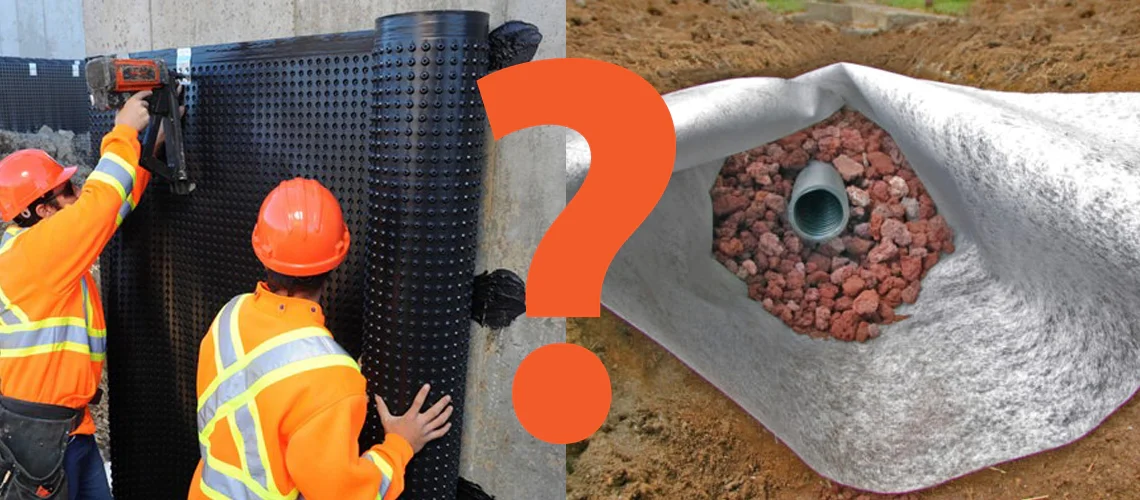When it comes to keeping your basement dry and your foundation strong, homeowners often face one important decision: French drain vs exterior waterproofing. Both methods offer effective ways to manage water around your home, but understanding how they work and when to use each one can make a major difference in your property’s long-term protection.
This article provides a detailed foundation waterproofing comparison to help you choose the best waterproofing method for basement protection based on your needs, soil conditions, and budget.
Contents
What Is Exterior Waterproofing and How Does It Work?
Exterior waterproofing is a robust and long-lasting method designed to block water before it even reaches your basement walls. This process involves:
- Excavating around the foundation of the home
- Cleaning and sealing the foundation walls
- Applying a waterproof membrane or coating
- Installing drainage mats or protective barriers
- Backfilling with gravel and soil to improve water flow
The goal of this method is to create a waterproof seal along the entire exterior surface of the foundation, directing water away from the home and preventing leaks or moisture buildup.
Benefits of Exterior Waterproofing
- Provides comprehensive protection against both groundwater and surface water
- Addresses foundation cracks and weak spots directly
- Increases property value and structural stability
- Ideal for homes with persistent moisture or poor grading
Considerations
- Higher upfront cost due to excavation and labor
- Can be disruptive to landscaping and patios
- May not be feasible in densely built neighborhoods
If you’re wondering whether to choose exterior waterproofing or French drain, think about long-term performance and how much disruption you’re prepared to tolerate.СТА:Not sure whether to invest in a French drain or exterior waterproofing? Contact our team today for a free consultation and find the most effective solution for your home’s foundation.
What Is a French Drain and How Does It Help?
A French drain is a simpler yet powerful drainage system that redirects water away from your foundation. It consists of:
- A trench dug around the perimeter of your home
- A perforated pipe placed at the bottom
- Gravel or stone used to filter and guide water into the pipe
- Connection to a sump pump or safe discharge area
French drains are designed to relieve hydrostatic pressure that builds up in saturated soil and pushes moisture against your basement walls.
Benefits of French Drains
- Less expensive than full exterior waterproofing
- Minimally invasive when installed indoors
- Excellent for managing surface water or water table pressure
- Can be combined with sump pumps for increased efficiency
Considerations
- May not seal foundation cracks or porous concrete
- Needs regular maintenance to prevent clogging
- Less effective in areas with extremely high water tables
If you’re deciding between a French drain or exterior seal, remember that a drain controls water — but it doesn’t stop it from contacting your foundation.
French Drain vs Exterior Waterproofing: Which Should You Choose?
When deciding between a French drain and exterior waterproofing, it’s essential to consider several key factors that impact performance, cost, and installation. Exterior waterproofing typically involves higher costs due to excavation, but it provides full exterior sealing and superior long-term effectiveness. It’s especially suitable for older homes with recurring water issues, although it may significantly disrupt landscaping during installation. In contrast, a French drain is generally less expensive and faster to install—particularly as an interior system—but it focuses on managing water pressure rather than sealing the foundation itself. It causes minimal disturbance to your yard and works well in combination with sump pumps, though it may require regular maintenance to stay effective. For many homeowners, especially in Toronto, a hybrid solution offers the best protection—combining the exterior seal of waterproofing with the water-redirecting capabilities of a French drain to ensure comprehensive defense against basement moisture.
СТА:Protect your basement before problems begin—schedule a waterproofing assessment now and get expert guidance on the best method to keep your home dry and secure.
French Drain or Exterior Seal: What Experts Recommend
For homes experiencing regular water intrusion or living in areas with high rainfall or poor drainage, experts often recommend starting with exterior waterproofing for its thorough protection. However, in homes where excavation isn’t an option — or for moderate moisture issues — a French drain system can be a practical and effective choice.
In many cases, a hybrid solution — combining both methods — offers superior protection against future water damage.



